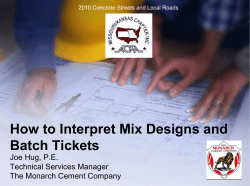
guide to the safe use of portland cements & concrete 1. introduction
guide to the safe use of portland cements & concrete 1. introduction Concrete is the world’s most widely used building material, and workers in every sector of the construction and precasting industries as well as DIY enthusiasts handle portland cement and wet concrete every day. As with most materials, there are potential risks involved in handling or working with portland cement or mixes made using portland cement. This document is intended to inform users of these risks, provide guidance on how to avoid the effects of unprotected exposure, and outline basic first aid procedures. Factors to be considered are listed below and each is then dealt with in more detail: • The composition of portland cement is such that when dry cement is exposed to water a chemical reaction called hydration takes place releasing a very strongly alkaline (and caustic) fluid. This can cause alkali burns and safety measures should be observed. • Similarly, appropriate precautions are advised to prevent tissue damage when handling fresh mixes containing water and portland cement. • Working with cement and concrete usually involves manual labour and lifting heavy loads. Care must be taken to avoid back and other kinds of strain due to unaccustomed physical labour. • Cement dust, dusts from handling aggregates and from cutting concrete are easily inhaled. Prolonged or regular exposure to these dusts should be avoided. Human skin is a vital organ composed of a complex structure containing fats and oils that make it supple and waterproof. In its natural state, skin is slightly acidic with a pH of about 5. When fresh concrete or its bleed water comes into contact with human skin, the alkalis react with the oils and fats in the skin as well as the proteins in the skin itself causing tissue damage. Other organic tissue (e.g. mucous membrane) can also be attacked by strong alkalis leading to burns that can sometimes be severe, and users should try to avoid all unnecessary contact with these fluids. Where such contact is unavoidable, suitable precautions should be taken. 3. recommended precautionary measures 3.1 Physical hazards Bagged cement is usually packaged in 50 kg units. Handling and moving cement bags should be undertaken with due regard for the possibility of back and other physical strains. Similar caution should be exercised when mixing, transporting, placing and finishing concrete as many of these operations may involve unaccustomed physical effort or working in awkward or uncomfortable positions for long periods. 3.2 Exposure to cement and other dust • Cement – This is an abrasive fine powder, and when handled, some dust may become suspended in the air in the working area. Users should avoid inhaling cement dust as this may cause irritation of the nose and throat. Cement dust may also cause irritation of the eyes. This will occur as a result of the chemical reaction of the suspended dust with the moist mucous membranes. 2.the chemical composition of portland cements Portland cement is a complex combination of compounds that includes minute quantities of trace elements. Although South African cements typically contain less than two parts per million of Hexavalent Chrome (widely regarded as a safe level), it may serve as an aggravating factor in cases of exposure to alkaline fluids. There have been some reports of allergic dermatitis after exposure to these fluids. • Silica dust – Many of the aggregates used in concrete have When portland cement comes into contact with water, a chemical reaction called hydration takes place producing a fluid that is very strongly alkaline (pH greater than 13). Every attempt should be made to keep airborne cement dust to a minimum to avoid these problems. Should this be impractical, then the use of goggles and dust masks is strongly recommended. high silica contents. The fine silica dusts created when crushing or handling these aggregates could cause lung problems, and precautions should be observed to avoid breathing in such dusts. • Dust from demolishing or cutting hardened concrete – This may contain unhydrated cement and could cause respiratory problems similar to those outlined above. In addition, if the coarse or fine aggregate used in making the concrete contains crystalline silica, then inhalation of these fine silica particles could expose workers to the risk of developing silicosis. A concerted effort should be made to avoid generating such dusts. If this is not possible, the use of suitable respiratory protective equipment is recommended. 3.3 Exposure to fresh concrete or mortar As mentioned earlier, the product of the hydration reaction between portland cement and water is a very alkaline fluid which has the potential to attack exposed organic tissue. When fresh concrete or its fluid comes into contact with human tissue, the alkalis react with the oils, fats and proteins in this tissue causing damage. Roughness and dryness of the hands after working with concrete is a typical consequence of loss of these oils and fats. More prolonged exposure could result in irritant dermatitis. It is possible that the effects of trace elements may aggravate the condition and lead to an allergic dermatitis. To safeguard against accidental exposure, appropriate protective equipment is strongly recommended: • Wear impermeable gauntlet type rubber gloves and high length rubber boots to prevent direct contact with skin. Trousers should overlap the boots rather than be tucked into them. • Apply hydrophobic alkali-resistant barrier creams to hands and any areas of skin likely to be in contact with fresh concrete. Ordinary barrier creams are likely to be inadequate. These precautions may be ineffective if the skin itself is not clean and free of concrete residue. Even a tiny trace of cement dust remaining in contact with wet skin will raise the pH significantly. For this reason, some authorities recommend the use of disposable gloves and discourage reusable gloves. • Regularly wash (at least daily) protective clothing and keep it clean and free of concrete. • Wash any areas that have been accidentally splashed with wet concrete as soon as possible with large quantities of clean water. Particular care should be taken to ensure that: • Normal and protective clothing does not become soaked with wet concrete or concrete fluids as this could result in exposure over an extended period, resulting in tissue damage that can be particularly severe and even disfiguring. • Workers do not kneel on fresh concrete during placing, compacting and finishing operations. If kneeling is unavoidable, thick waterproof kneepads should be worn and a kneeling board used to prevent the pads sinking into the fresh concrete. In severe cases of alkali burns, a medical practitioner should be consulted as soon as possible. 4. first aid and remedial treatment 1. Carefully remove wet concrete-soiled clothing. Although some first aid books state that clothing should not be removed from a burn wound, concrete burns are chemical burns – not heat burns – and clothing will not normally adhere to the wound. 2. Rinse the affected skin as soon as possible with cool clean water. If the skin is treated soon enough (before ulceration), vinegar can be added to the rinse water to neutralise the alkalis (half a bottle of vinegar to a bucket of water). Milk (which is a good natural buffer) can thereafter be applied to the skin with a pad to neutralise any further traces of alkalis without risk of acid-burning the skin. The skin should then be dried by gently dabbing with a towel, and lanolin may be applied to replace lost fats and oils and to restore suppleness. 3. If ulceration has already set in, do not attempt to treat the wound with anything other than clean water without first seeking expert medical advice. The risk of spreading infection to the wound at this stage is severe. 4. A sterile burn dressing can be applied over the wound and bandaged. An ice pack can be applied afterwards above the dressing but not directly to the skin. 5. Do not delay getting medical treatment as the alkalis will continue to destroy tissue. Important: It is advisable to notify any medical authorities that the victim should be treated for “alkali burns” as many medical practitioners may be unaware that concrete is a highly alkaline material that can cause third degree burns. cement & concrete institute po box 168, halfway house, 1685 block d, lone creek, waterfall park, bekker road, midrand tel 011 315 0300 • fax 011 315 0584 • e-mail info@cnci.org.za • website http://www.cnci.org.za published by the cement & concrete institute, midrand, 2009. © cement & concrete institute
© Copyright 2025





















